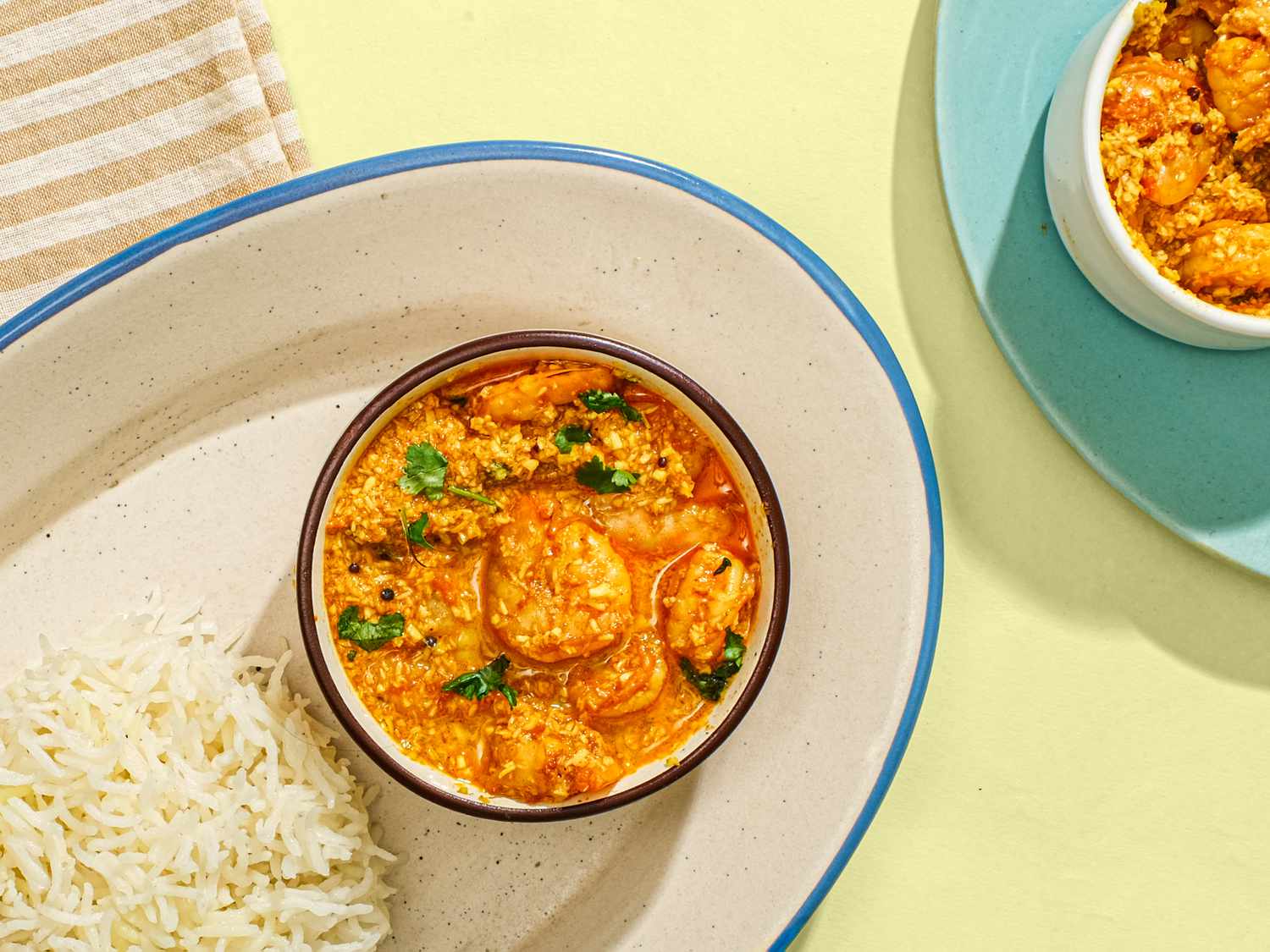
Why It Works
- Contemporary grated coconut floor right into a silky clean paste provides richness and physique to the dish.
- A freshly ready tamarind paste provides the dish a splendidly tart, acidic taste and pickles the shrimp because it sits.
One among my favourite methods to eat shrimp is the Indian dish khadkhadi, plump shrimp simmered in a wealthy and tart sauce that includes elements generally used within the west coast of the nation, together with tamarind and coconut. I discovered how you can cook dinner khadkhadi from my mom’s sister, Maya Kale-Laud, who cooked it usually. It’s so liked by me and my household that Maya even contributed her recipe for it to my cookbook The Essential Marathi Cookbook.
The dish’s identify is an onomatopoeia: In Maya and my mom’s mom tongue of Marathi, khadkhadna refers back to the effervescent sound made by the elements cooking in a sizzling liquid. Within the dish, shrimp are first brined to provide them a plump, snappy texture, then they bubble away in a velvety coconutty sauce made tangy from tamarind pulp. It’s delightfully savory, somewhat candy, and acidic all of sudden. As a result of the sound of the shrimp cooking is loud, I lovingly discuss with the dish as “noisy” shrimp.
Maya Maushi—Maushi means mom’s sister in Marathi, the language of my state, Maharashtra—usually cooked khadkhadi for her seafood-loving household, and it’s simple to see why: It’s a fast dish, prepared in lower than an hour and may be served sizzling straight away or eaten chilly as a pickled condiment for the following 5 days. Because the shrimp brine briefly, you may soak the tamarind and make the coconut-garlic paste. Then after a mere quarter-hour of cooking, dinner is prepared.
Scorching, khadkhadi is a filling major course on white rice or a flavorful snack on toast. Out of the fridge, it may be used as a satisfyingly spicy condiment with Indian meals or served chilly on dressed greens for a lip-smacking salad. I maintain the essence of Maushi’s recipe right here, tweaking it solely barely. Listed below are a number of suggestions for making this candy, tart, and savory coconut and tamarind shrimp recipe at residence.
Severe Eats / Kanika and Jatin Sharma
Ideas for Cooking Coconut and Tamarind Shrimp
For juicier shrimp, brine with salt and baking soda. Tossing the shrimp with salt and baking soda briefly earlier than cooking greatly enhances the shrimp’s flavor and seasoning; brining with salt ensures the shrimp stay moist as they cook dinner, whereas alkaline baking soda delivers a pleasantly agency texture.
Right here, I toss the shrimp with the salt and baking soda plus crimson chile powder and floor turmeric for extra taste. In my exams, I discovered that the shrimp had the very best taste and texture when brined for 30 to 45 minutes. Simply make certain to refrigerate them throughout this time so that they keep contemporary, and use a glass or metallic bowl that won’t stain from the colourful turmeric and chile powder.
Begin with frozen contemporary coconut flakes for a flavorful sauce. Whereas Maushi used a grinding stone to make her coconut and garlic paste, right here I name for a meals processor. Utilizing a meals processor requires including water to the coconut combination to make sure the processor’s blade catches the combination and blends till clean. (When you desire to make use of a mortar and pestle, you may omit water initially and add one tablespoon at a time if wanted to loosen the combination.) Be sure that to make use of frozen contemporary flakes, not desiccated or dried sweetened flakes. Contemporary coconut flakes have a richer, extra intense coconut taste than dried varieties do.
Make your personal tamarind paste; it’s simpler than you assume. Retailer-bought ready tamarind paste is on the market at many Indian meals markets, and should seem to be the simpler choice since little to no prep is required for it, however I strongly advocate not utilizing ready tamarind paste, which may range drastically in texture and taste and so they usually lack the depth of taste and thicker texture of a paste that’s freshly ready with tamarind pulp. As a substitute make your personal paste from scratch with tamarind pulp; the trouble is price it for the balanced tart and candy taste it provides to the ultimate dish. I like to recommend utilizing Indian tamarind pulp, as Thai tamarind pulp is often too candy for this savory utility.
Begin with a tamarind pulp block and reduce or pinch off two ounces from the bigger block into two-inch chunks. From there, steep it in boiling water for quarter-hour to melt, then squeeze and mash the pulp to separate it from the fibers and seeds, and at last press it by way of a fine-mesh strainer. Be sure that to make use of a versatile spatula to scrape off any usable paste that adheres to the underside of the strainer, and add it to the bowl with the remainder of the paste. This course of separates and removes the fibers and seeds from the pulp to type a thick, candy, tart, and complicated tasting paste.
Serve sizzling or chilly. One among my favourite issues about this recipe is that it’s nice served sizzling proper after cooking as a major dish, however it is usually great when cooled down, refrigerated, and served chilly. Because the shrimp sit within the acidic tamarind and coconut sauce, they pickle and develop a brighter, sharper taste over time. The acidic sauce preserves the shrimp to allow them to last as long as a full week within the fridge.
Severe Eats / Kanika and Jatin Sharma
When you plan to eat the shrimp as a major course, I like to recommend utilizing giant shrimp. However When you plan to refrigerate it and serve it as a condiment or salad topping later, I like to recommend utilizing small shrimp. I discover that smaller shrimp clump collectively extra within the sauce and are simpler to spoon as a cohesive topping on toast, which is how I prefer to get pleasure from it. Consider the small items of mango you discover in a mango pickle or chutney—you’ll have the same expertise with spreadability if utilizing smaller shrimp.
Trending Merchandise











